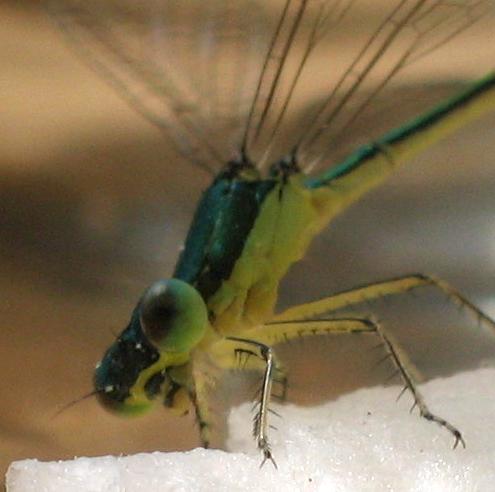Green Damselfly
In case you were wondering what last weeks damselfly nymph would have grown up to be, it would have been something like this:

This is another one that we caught with an insect net down at Chassell Beach on June 20, the same day that we caught the Clubtail Dragonfly. I mainly caught it by luck, I saw a flicker of movement, took a swipe with the net at the general vicinity, and there it was. I would say that it is probably one of the Spreadwings, family Lestidae, based on the way that it holds its wings partly spread out when it rests. Other damselfly families rest with their wings folded flat along the abdomen.

They are fast-moving aerial predators that hunt by sight, like dragonflies, although they are a lot smaller. This one was maybe 3 cm long, but so slender that it was hard to see it. Even the bright metallic green color didn’t make it visible [1]. But it could certainly see me, just look at those eyes:

They have pretty much all-around vision, they can even see directly behind them. I like the effect in this picture that was taken from behind, where the “pupil effect”[2] makes it look like it is staring straght back over its shoulders at me:

People give dragonflies a lot of credit for eating mosquitos, but actually I think they concentrate on larger prey. The little damselflies are probably much more important for eating mosquitos and midges, I think. Anyway, between the nymphs massacring the mosquito larvae[3], and the adults devouring the flying mosquitos, I think that these are very effective for mosquito control.
——–
[1] If they had a lot of surface area, that reflective green would make them stick out like a sore thumb, but there’s something about a very thin reflective object that makes them hard to see clearly. It might be that it makes them look like a reflection glinting off the water rather than a solid object. Anyway, I find that damselflies are actually easier to spot by looking for their shadows than it is by looking at them directly.
[2] In a lot of insects that have very high-resolution compound eyes, there is an effect where the eye appears to have a dark pupil, that is always looking straight at you. This is an artifact of the way the eye is constructed, where the individual compound eye elements that are pointed directly at the viewer look darker than the elements that are pointed slightly away. That still doesn’t stop it from being a slightly creepy effect, though – kind of like the way that certain paintings look like they are watching you.
[3] The only problem is, mosquito larvae can live in stagnant, oxygen-poor water (because they actually breathe air through snorkels), while damselflies have to have oxygenated water (because they breathe through gills). So, a lot of mosquitos live where damselflies can’t.

Comments are closed.